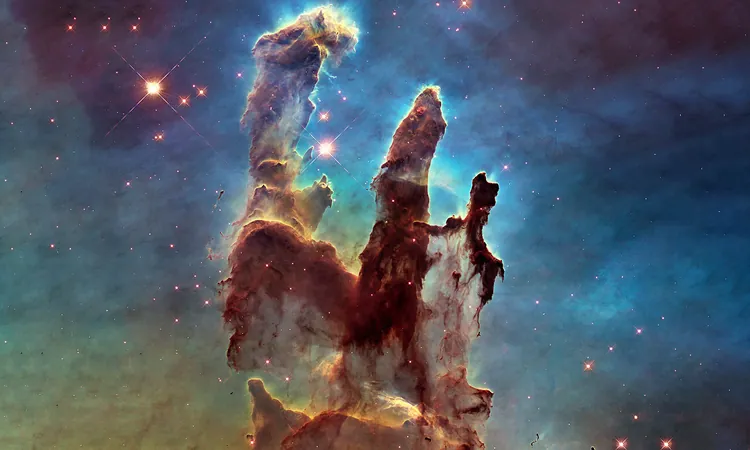
35 Years of Hubble: A Cosmic Journey That Redefined Our Universe
2025-05-03
Author: Wai
Celebrating 35 Years of the Hubble Space Telescope
The Hubble Space Telescope, a monumental marvel in astronomical history, is officially 35 years old! To commemorate this incredible milestone, NASA has unveiled a stunning new gallery of images, showcasing everything from the rugged terrain of Mars to the luminous nebulae and neighboring galaxies.
These breathtaking visuals not only serve as a celebration for the public but also highlight how profoundly Hubble has reshaped our understanding of the cosmos and influenced popular culture.
From Blurred Beginnings to Clear Vision
On April 24, 1990, the space shuttle Discovery launched Hubble into the cosmos, introducing what was touted as 'a new window on the universe.' However, joy quickly dimmed when engineers discovered a painful flaw in the telescope's mirror, leading to blurry images.
Thankfully, in December 1993, astronauts executed a delicate servicing mission, installing corrective optics akin to a pair of glasses for Hubble. This ingenious fix restored its vision and opened the door to three decades of groundbreaking discoveries.
An Unending Source of Discovery
Since that pivotal repair, Hubble has made approximately 1.7 million observations of around 55,000 celestial entities. These efforts have culminated in over 22,000 scientific papers and an astonishing 1.3 million citations, solidifying Hubble's status as the most scientifically productive telescope ever.
With more than 400 terabytes of raw images and spectra publicly archived, Hubble fuels continuous discoveries, enabling astronomers to monitor the dynamic changes in the universe.
Revolutionizing Our Understanding of the Cosmos
Before Hubble, Earth's turbulent atmosphere limited ground-based observatories, resulting in wildly varying estimates of the age of the universe. But with its legendary Deep Field images revealing a host of ancient galaxies, Hubble transformed these narratives.
By tracking cosmic phenomena such as Cepheid variable stars and Type Ia supernovae, Hubble pinched the cosmological expansion rate and contributed to unveiling dark energy—an achievement that earned the 2011 Nobel Prize in Physics.
Crafted for Longevity and Success
A significant factor in Hubble's success lies in its design, which allows for servicing. Between 1993 and 2009, Hubble welcomed five shuttle crews that upgraded its systems, enabling this colossal telescope to adapt and thrive over time.
Even post-2009, Hubble has continued to function splendidly, thanks to ingenious software updates and remote troubleshooting techniques developed to tackle aging hardware.
A Cultural Icon Beyond Science
Hubble's mesmerizing images—like the Pillars of Creation and the Horsehead Nebula—have captured public fascination, turning complex astrophysical data into vibrant art that inspires awe and curiosity. Its success has shown that deep-space exploration transcends scientific communities, igniting wonder in everyone.
The Future of Space Exploration
As Hubble's legacy continues, it will pave the way for NASA's proposed Habitable Worlds Observatory (HWO), set to launch in the 2040s. Designed to be significantly more sensitive and serviceable, HWO aims to explore Earth-like planets in habitable zones and search for signs of extraterrestrial life.
A Legacy That Keeps Unfolding
Orbiting at an altitude of about 330 miles, Hubble continues its mission, scanning the skies every 97 minutes and offering fresh insights into cosmic phenomena. From its rocky start to its meteoric success, Hubble exemplifies human ingenuity, resilience, and the insatiable quest for knowledge.
NASA’s recent image release serves not only as a birthday tribute but also as a reminder that high above us, Hubble remains a steadfast explorer, ready to invite all who look up to dream once more.



 Brasil (PT)
Brasil (PT)
 Canada (EN)
Canada (EN)
 Chile (ES)
Chile (ES)
 Česko (CS)
Česko (CS)
 대한민국 (KO)
대한민국 (KO)
 España (ES)
España (ES)
 France (FR)
France (FR)
 Hong Kong (EN)
Hong Kong (EN)
 Italia (IT)
Italia (IT)
 日本 (JA)
日本 (JA)
 Magyarország (HU)
Magyarország (HU)
 Norge (NO)
Norge (NO)
 Polska (PL)
Polska (PL)
 Schweiz (DE)
Schweiz (DE)
 Singapore (EN)
Singapore (EN)
 Sverige (SV)
Sverige (SV)
 Suomi (FI)
Suomi (FI)
 Türkiye (TR)
Türkiye (TR)
 الإمارات العربية المتحدة (AR)
الإمارات العربية المتحدة (AR)